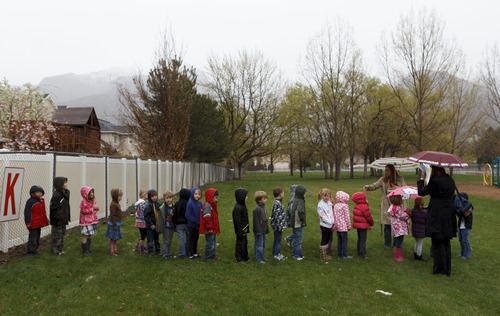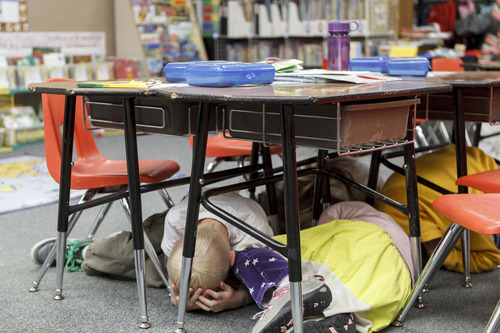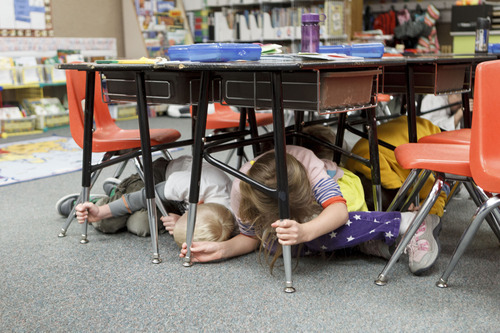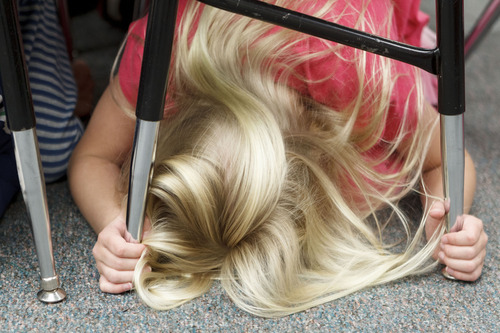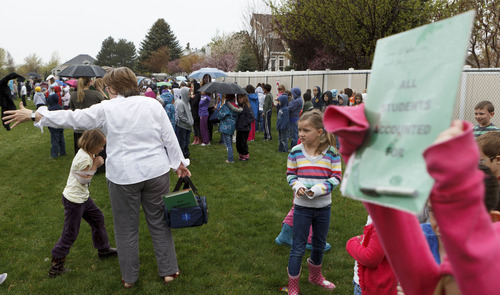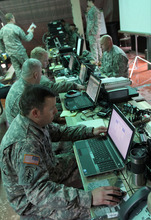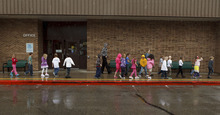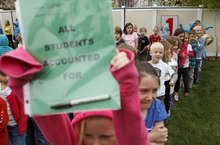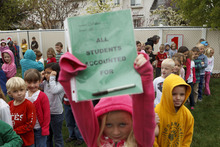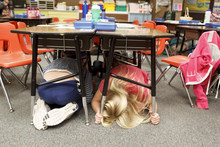This is an archived article that was published on sltrib.com in 2012, and information in the article may be outdated. It is provided only for personal research purposes and may not be reprinted.
A 7.5 magnitude earthquake hit Utah Tuesday morning, and nearly a million people were prepared for it.
But just how prepared the state was for the mock quake, which hit at 10:15 a.m., won't be realized until the end of the week. Officials will continue the state's largest ever earthquake drill through Thursday, dealing with the aftermath of the disaster: broken freeways, ruptured gas lines, collapsed skyscrapers, and downed communications.
"What we are learning right now is how fast the local resources can get used up," said Utah Task Force One Capt. Ryan Mellor Tuesday from his post at the Emergency Operations Center inside the basement of the state capitol.
Mellor was one of many who were collecting data and information in the new, buzzing emergency hub. It houses about 14 flat screen televisions displaying resource usage, social media, traffic, news, and seismograph information. Representatives from agencies and groups including the Red Cross, National Guard, Emergency Management and Department of Public Safety packed the room.
Mellor said the drill, dubbed the Great ShakeOut, felt realistic.
"This is taking what we do to another level," he said while helping to prioritize which areas needed help first.
On the other side of the valley at Granite Elementary in Sandy, first grade teacher Victoria DiPietro's 23 students were quietly sitting on rugs in the classroom when they heard rumbling, shaking, banging and crashing sounds come across the building's intercom system.
That was their signal to scurry under their desks and hold on, some of them with white-knuckled and giggling nervously as they anticipated the next sound. After a brief pause on the recording, their teacher reminds them to be quiet. When the sounds start again and then dissipate, the children do a mock evacuation by walking outside and lining up by a fence in the pouring rain. When everyone is accounted for, they are allowed to go back inside, but are cold and wet.
One student from the class, Brinley Newitt says, "it is better if you get wet or snowed on than get hurt."
DiPietro debriefs the students afterward. Many of them commented the experience was "cooler" than a fire drill. Some admit they felt a little scared. And Calla Jordin explained the difference between the drill and a real earthquake: "I would be protecting myself and say 'Oh no, this is not good.'"
The drill aims to increase preparedness for a real threat. If a magnitude 7.0 quake were to occur, state officials have placed the projected death toll for the nine counties along the Wasatch Front at about 2,500 people, with about 2,000 would suffering life-threatening injuries.
At LDS Hospital, Tuesday's drill kicked off at 9 a.m. when an announcement activated the emergency room for an unusual event. By 9:30 a.m., the command center team practiced how to deal with a non-functional disaster hotline, a report of deaths across the valley, a doctor shortage, 30,000 reported injuries and structural damage at four Intermountain Health Care hospitals.
Hospital personnel at a triage station at the ER entrance quickly sorted arriving high-school students according to their injuries: green for cuts and bruises; yellow for those needing immediate medical attention; red for critical life-threatening injuries; and black for those either dying or already dead.
Micaela Tracy and Gabriel Muñoz, both 17-year-old Cyprus High in Magna, shared a gurney as they were wheeled to the hospital's morgue, actually a conference room. They "died" from head injuries that spilled brain matter — gruesome makeup — onto their faces.
In a room set aside for others classified in triage as in black condition, patients were still alive but considered so gravely injured that treating them would be fruitless, especially with limited medical personnel and so many casualties. In a real situation, they would have been given morphine and palliative care. Their loved ones would be allowed to sit with them. A chaplain would be available if anyone needed spiritual care.
Ali Mahamat didn't know all that. The 17-year-old Highland High student was in a holding pattern, waiting for surgery with a severed spine. In the drill scenario, he said, "I was impaled with a metal beam. I was conscious, then intubated, then I was sedated."
A patient in need of an amputation had been deemed more critical. If the situation were real, and he was conscious, "I would probably be mad," Ali said. "I would probably keep asking, 'Where's my mom and dad? Do they know what happened to me?' I would probably try to get home as fast as I could."
But as he thought through the situation, acknowledging he knew nothing about Utah's real earthquake threat, he realized his three siblings and parents would all be in different places. The family hasn't talked about what they would do in a disaster, where they should all try to meet.
Maybe, he said, they would talk about it that night.
At Dan's Market in Salt Lake City, one of many businesses who took part in the drill, employee Jeanne Perkins knew just what to do. Perkins, who runs the customer service desk, crouched under a table in the floral department at the entrance of the Foothill Avenue grocery store.
"I went through the 1971 Sylmar earthquake in Southern California," Perkins said of the tembler that struck the San Fernando Valley with a magnitude of 6.6. in the morning hours.
Perkins said her home wasn't damaged, but many people stayed in their beds and were injured by objects flying off furniture and shelves.
Grocery manager Paul Badge reminded employees to take cover under heavy desks, tables or walk-in coolers.
"There's a lot of items on our shelves," he said. "You don't want to be standing near any of them."
The drill is part of the chain's safety program, in which team members meet weekly to discuss keeping the workplace safe for themselves and shoppers.
During an earthquake, employees were reminded to stay inside. If cooking, quickly turn off equipment. Watch for falling product debris, and if possible take cover. If there's nothing sturdy to hide under, go to an inner corner of a doorway.
And, stay away from windows, glass panels, large equipment and those pesky shelves.
Shopper Jennifer Allen listened to the store announcement of the drill.
"This is a good idea," she said. "I myself need to know more what to do."
After the damage took place, Blackhawk helicopters took to the skies as the Utah National Guard also tested out communication devices with state and local authorities. About 400 soldiers around the state with the Army and air National Guard participated in the training drill.
Utah National Guard Brigadeer General Jeff Burton said Tuesday afternoon, "I'm encouraged things are working as well as they are."
He said it was important to have"synergy" between agencies communicating with each other to make assistance streamlined. However, it also helps when residents are self-sufficient with their own food kits and supplies because sometimes it may be "hours to days" before emergency crews arrive. —
Web reaction
storify.com/ElizabethNeff/the-great-utah-shake-out-2012 —
Effects of a major quake
Injuries and deaths from a major quake
The number of injuries and deaths would depend on the time of day of the earthquake. The Utah Division of Homeland Security analyzed the scenario of a 7.0 temblor hitting Salt Lake County at a time when everyone is home, everyone is at work, and when people are commuting.
Level 1 • scrapes and bruises
Level 2 • hospitalization with non-life-threatening injuries
Level 3 • life-threatening injuries
Level 4 • fatalities
2 a.m.
Level 1 • 31,430
Level 2 • 9,360
Level 3 • 1,480
Level 4 • 2,920
2 p.m.
Level 1 • 22,830
Level 2 • 7,060
Level 3 • 1,200
Level 4 • 2,290
5 p.m.
Level 1 • 23,520
Level 2 • 7,790
Level 3 • 2,290
Level 4 • 2,450





